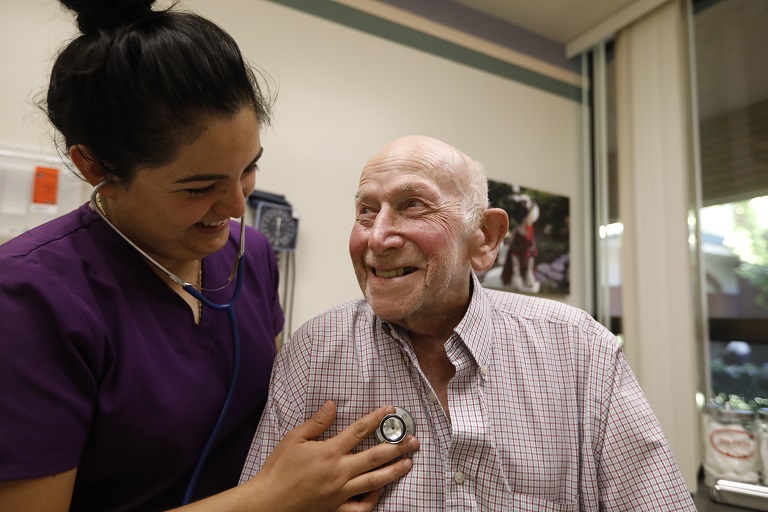Middle Market Panel: A Summary of the LPC Advisory Group
First Question: What IS the middle market?
Beth Mace: It is a group of individuals who have too many financial resources to qualify for government support programs such as Medicaid, but don’t have enough resources to use private pay options for very long. Right now – 7 million individuals in 2014; by 2029, there will be 14 million. Lots of people who need care and housing in a way that they can afford it. Also looked at comorbidity and chronic care needs. Fewer adult children to care for these folks. Need for institutional settings.
Second Question: What resources have your organizations developed and how do they help us understand the middle market question?
· Beth Mace: NIC 2019 – The Forgotten Middle. Lays groundwork for future conversations. www.nic.org/middlemarket.
· Melissa Andrews: LeadingAge Virginia – Middle Market Playbook. We convened a group of members. A model for not-for-profit communities – smaller side, in Virginia. Expand missions, get back to roots to serve retired ministers [and other older persons.] Affordability has gone through the roof. Service enriched housing. Pulled from affordable housing brethren.
· Colin Milner: International Council on Active Aging. New opportunity and a new day. Need to look at things differently. We held a think tank 6 months ago. Wellness and the Middle Market Forum report was the result. Wellness as key component. We need new thinking and a new model. New rules, new places, new programs, new education, new language, new thinking. Key findings – separate the new model from current models so that it is distinguished as its own line of business.
Third Question: Why is it hard for our field to get our arms around the middle market? And why were you inspired to tackle this challenge with your organization?
· Melissa Andrews (MA): It took six months of debate before our panel members were willing to let go of the traditional LPC model and begin to build something new. Find mission in a different type of housing and services. Let go of the entry fee model. Biggest challenge was letting that go; in not taking a CCRC and stripping it down.
· Colin Milner (CM): The exciting reality is that this is a new opportunity and requires new thinking. This is not senior living as we know it. We must create a new category. That is what precipitated our forum; how do we look at this market and what impact will it have on the industry? A low percentage of population utilizes our current housing options. How do we create a model that applies to the masses? At the heart is three words: aspiration empowerment and access.
· Beth Mace (BM): Hard nut to crack because it is both housing and care. As you grow in acuity, care becomes more expensive. How to create a home that has services that people can afford?
· MA: The brand issue. What is the perception by current stake holders of creating a ‘lesser product.’ Issue with current residents. Branding is a challenge.
· CM: Brand promise: how do you live better longer by moving into this community? And then how do you fulfill that and market it?
Fourth Question: How can a leader undertake this middle market venture, especially when so broad and multifaceted? What should a leader be thinking about and considering?
· MA: Leadership questions – mission questions, operational questions. What is our core competency? What are our non-negotiables? Is this our moral covenant? What risk are we willing to take on to expand our mission to serve a new market? Operationally – do we have the bandwidth for this? What future organizational structure do we need? What areas of expertise do we need around the table?
· BM: Need to understand the customer. This middle market group has a different profile than traditional senior housing. They want to live within their means. Unbundle services and do a-la carte offerings. This is a way to lower the costs. People do not want to outlive their assets. Focus on the customer.
· CM: In our report, eight words that describe the middle market. Value Driven. Choice. Flexible (from provider standpoint). Social. A la Carte (Unbundled services, pick and choose what the individual wants.) Self-Reliant. Diverse & Multicultural. Prudent. Involved. (In decisions and making community come alive.) Top three: flexibility, collaboration, adaptability. To address this market’s ebbs and flows.
· MA: The middle market (MM) doesn’t define themselves as MM. We must be careful in conversations. Just because they can’t afford it doesn’t mean they don’t want it. How do we met their needs and help educate what choices they have for the money they can spend?
· CM: Two simple concepts: 1) Cut – decrease services but increase quality. Or 2) Open- the community to the greater community, and let the revenue from that help offset costs of providing the broad array of services. (Dining venues, fitness, pools, etc.) Challenge – which area do you want to fit in?
· BM: Makes me think of partnerships. In the new product is partnerships. You do what you do well, and partner with others for the rest: food service, healthcare, home care. Partner with nearby restaurants, discounts for residents.
· CM: Who do you partner with for care? Recent report from Deloitte, by 2040 we expect the consumer to be at the center of the health and healthcare solution. What are the elements that we need to master to help us facilitate that with current and future middle market resident? Radically inter-operatable data. Hyper-engaged consumer. Care on demand, rather than care on property. When the person is at the center of that, what does that mean?
· MA: Affordable housing folks know how to navigate this for the resident. Our Playbook focuses on partnerships. More JVs on home health and hospice side. Two strong organizations come together to create a model that benefits a larger market. Services that you can bring in. Look at front end – what other organizations have similar missions and values to create the MM entity?
· CM: 90% of healthy older adults define successful aging as doing the things they want to do when they want to do them. Helping people remain independent through wellness. Good for the individual AND good for business.
· BM: The consumer we are talking about is different than the current one. Much more engaged and purpose oriented. For them, there’s more to life in retirement. Purpose-matchmaker instead of activities director. People want quality of life. Boomers will bring many changes and demands.
· CM: Talk in industry over the years that this is a “last stop” (retirement communities). The reality is (from ICAA’s current survey) that only 3% see senior living as “a place to go to die.” Staffing is a big part of the new challenge – less staffing because of service. Staff will have to be cross trained. Quality of staff training is even more important. Universal worker instead of a specialist.
· MA: Our Playbook model builds in the staffing. Includes Care Navigator position to help people access what they need. Also included an amenity space calculator in the Playbook model. You can put in what your non-negotiables are and then the model generates your bottom line. How can we get creative to make sure they have access to what they need if we aren’t providing it on site?
· CM: Care FOR might become a term that doesn’t apply to this market. Care WITH may be the better term for this market. How do we manage that flow between the community and the greater community? One recommendation is that the MM community becomes a hub for the external community that pays for many of these services. Engage all ages, intergenerational housing. Are your services designed to address that shift as well. We are already seeing that. How does it play into this model?
· BM: Population health management. How can you best encourage people through lifestyle to try to elongate the quality of their life and length of stay in a property?
· CM: Before pandemic, 59% of ICAA members saw themselves as ‘wellness-based communities with care’ moving forward over the next five years. Some changes are happening. Intergenerational. Technology. Wellness. Focus on individual. Opportunity is to RAMP UP that change rather than go at a slower pace.
Question Five: You’ve all mentioned great concepts: autonomy, choice, affordability. Person directed care. I wonder – what about the fact that many of these middle market adults are projected to have a higher level of comorbidities and yet marginal resources to pay for care for those comorbidities? If I want to develop a MM program, and figure out how to serve which segment, what does that mean? The fact they will still want amenities, need greater care, have fewer resources -how do we plan for that?
· BM: The 85+ cohort: 73% expected to have mobility limitations; 33% high needs (3+ chronic medical conditions and 1+ ADL limitations.) 15% with [some form of] cognitive impairment. Not a monolithic group. Different providers will focus on different angles, acuity levels, income strata. Pick which group you want to focus on and target on them.
· MA: We [the Playbook group] were looking at the group right below entry fee affordability for a CCRC in Virginia. That is what our group felt comfortable with, for financial feasibility. Lesson learned: our LeadingAge member community has affordable housing providers who are doing extraordinary things that are addressing these very issues. We can learn a lot from them. Have those providers at the table – they know how to do this. Let’s not think that this is all new work. This work has existed but for a different segment of the market.
· CM: There are a lot of people out there today with chronic health issues. 63% are functioning well, managing their health issues. Choosing your market and understanding what the challenges are is important. The WHO changed their definition of healthy aging to focus on ‘maintaining one’s functioning abilities and intrinsic capacities.’ Many are managing well through lifestyle changes or medications – but not everyone.
· MA: You will not increase your operating margins. This is not a money maker. It is a stretch to be budget neutral. [It’s about] getting back to our mission and roots, why we were founded. It’s not right that even our own staff could not afford to live here [in a CCRC.] Can we expand the mission to a greater group of people? One provider in LeadingAge has used our Playbook for 6 months; they convened a wide stakeholder group to build a MM product. Have a piece of land, creating strategy. They wanted to create more diversity among resident population. However – important point – affordability and cultural diversity are not hand in hand. There are people who can afford to live in CCRCs but don’t because culturally they do not feel welcome – not because they don’t have the resources to afford it. It is a sobering and essential point and assumptions we make about diversity and affordability must be questioned. Still very much driven by the local market. Your resident population may have a lower income and still look the same (as each other) and similar to your CCRC population. Lower income product does not mean you will have more diversity; we must abandon that thinking.
· BM: Studies showed that 9% of all of MM income population would be “diverse,” grows to 16% by 2029. Moving in that direction.
Questions from the Chat:
To help assure the success of the MM model, should we push for a higher income alternative to the Medicaid Assisted Living Waiver ?
· MA: We don’t have affordable AL in Virginia, so that would be a big push for us. This is a big notion. I’d be really open to seeing how that could happen. Our Playbook model was not based on this being “AL Light.” How do we finance LTSS in this country? This group particularly can be helped by this. This has been an important policy imperative from LA for the last two decades. Some states do have options – VA doesn’t. We learn from other states and try to get that done in our legislatures.
· BM: If we can do that- great. It’s pretty challenging. Just the sheer numbers of people aging into the need category will limit the ability to expand the program. We need to think outside the box.
· CM: The diversity of the market and the diversity of the solutions. Many things will be tried; some will fail, some will succeed. Definitely worth trying.
Regarding unbundling services: would you agree that unbundling services increases the cost of services? Example of # of meals per month and associated costs.
· MA: Do you have to provide meals? What do you have to provide vs what you are helping residents access? You don’t have to provide all the things you currently do now. Unbundling is different from starting from the ground up and asking, what will we offer in-house and what will be partner in order to provide?
· CM: Someone to assist with a la carte or concierge services. Same result in our think tank – food is a big issue. Many in our group envisioned that it would not be provided by the property but through a partnership.
· BM: Volunteerism is a way to reduce staffing and overhead costs. A number of CCRCs are pushing volunteerism, roll up your sleeves and do things that need to get done, residents helping residents. Boston examples: the Opus Model. A true volunteerism model, residents volunteer to provide services and then it reduces their overall costs.
· CM: Some services on property you may contract out for someone else to run. A spa, etc. Open it up to outside population, negotiate a lower fee for your residents, but it’s not part of YOUR bundle.
Since the MM is a specialized business opportunity, what do your studies show about who is serving that market today and who do you see moving into that segment?
· BM: There are several not-for-profits who are working on this. HumanGood. Private sector groups also – for profit. Trying to figure out more cost-effective ways to deliver the model. Merrill Gardens. Atria, Affinity Senior Living. This is exciting; a few years ago this wasn’t being discussed. Now – WellTower, a big REIT, is interested. No one has the special sauce yet, but lots of discussion, very proactive.
· MA: Differentiator is the healthcare navigation piece, the case navigation piece. What happens when you need services? And you will need services? Our Playbook felt this was it. This is what is missing in the market for people to age in place.
· CM: Rethinking of models, period. Communal living, tiny homes, villages, wellness communities, CCRC light, etc. It screams that people are looking for a new model – which one is going to stick?
We ran out of time for the remaining attendee questions, which the panelists agreed to try to answer in writing after the session.
Dee thanked all the panelists for their participation, wisdom, and learning shared. Then, she reminded everyone about the upcoming October and November LPC Advisory Group sessions and opportunities to network at the National Annual Meeting. The meeting adjourned at 3:00 p.m. EST.

Most Recommended
October 15, 2025
 Shutdown Week Three: Impact of Ongoing Closure on Affordable Housing
Shutdown Week Three: Impact of Ongoing Closure on Affordable Housing
December 10, 2025
Fiscal Year (FY) Funding 2026
October 07, 2025
Immigrant Workforce Matching Program Brings Workforce Relief
Recently Added
December 19, 2025
House Moves Forward on Affordable Housing Reforms
December 19, 2025
White House Cannabis EO Paves Way for Research, Access
December 19, 2025
LeadingAge Urges DHS to Maintain "Public Charge" Guardrails
December 18, 2025



